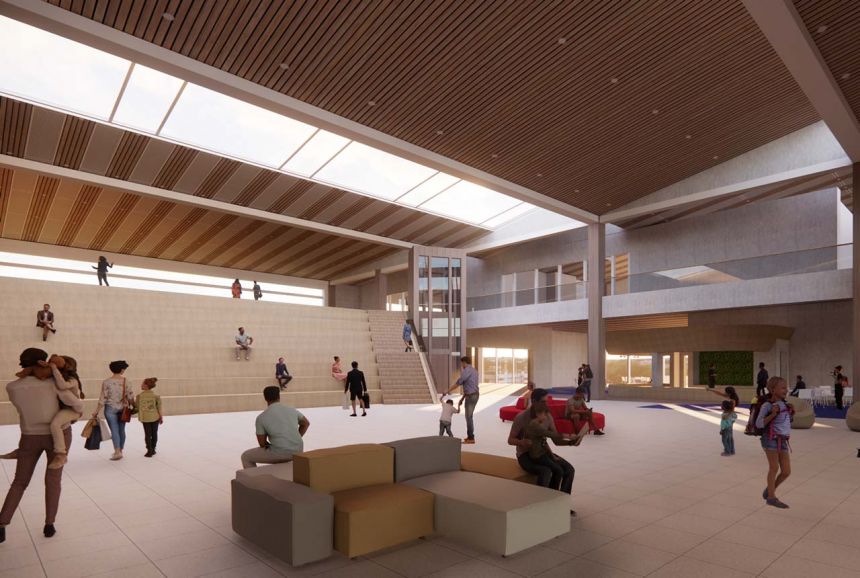Student Team Wins International Building Design Challenge with Community-Focused Shopping Center

An Illinois Institute of Technology student design team won the Retail Building Division of the United States Department of Energy Solar Decathlon® Design Challenge. The interdisciplinary team, featuring students from Armour College of Engineering and Illinois Tech’s College of Architecture, created an environmentally sustainable building designed to fit a real empty lot in Chicago's Goose Island neighborhood and developed the design with that community’s needs in mind.
The Solar Decathlon challenges national and international collegiate teams to design highly efficient and innovative buildings powered by renewable energy.
Illinois Tech students worked on this project in CAE 556/557 Net Zero Energy Home Design I & II, taught by Lecturer of Civil, Architectural, and Environmental Engineering Edoarda Corradi Dell’Acqua in the fall and spring semesters. These courses are part of the core curriculum of the new Master of High Performance Buildings, a joint Armour College and College of Architecture program.
“The design challenge prepares students for the future by teaching them to work on a team of people with very different skill sets and to make compromises. There’s also the storytelling element where the students have to learn how to communicate their work, plus the project opens up the opportunity for students to meet a lot of industry partners,” says Corradi Dell’Acqua.
The course is centered on the idea of net zero energy, where a building produces as much energy as it uses over the course of a year by also housing a renewable power source.
Nearly 7 million people in the U.S. are employed in the traditional energy and energy efficiency sectors. Corradi Dell’Acqua says, “Probably the most important part of the class is that it opens students’ minds to different possible career paths and to the broader vision of the need to go in the direction of reducing the energy consumption of our built environment.”
This year the Illinois Tech student team designed an 82,000-square-foot building called The Nook, which explores the future of retail through a mix of community and commercial spaces, a strategy for drawing people to shop in person rather than online.
Aiming to serve students attending nearby Goose Island schools, the building was developed with a first floor that would serve as a retail space for products such as books, art materials, and school supplies. The team designed the second floor with rentable multipurpose rooms that could be used as craft rooms, conference rooms, or art galleries, giving visitors the opportunity to use the supplies they just bought downstairs.
“The Nook becomes not just a retail store, but also an experience,” says Margarita Ramirez-Rodriguez (ARCE, M.Eng. ARCE 5th Year).
To achieve net zero energy, the students implemented a solar panel array on the building’s roof and used a range of strategies to make the overall design environmentally friendly. The team lead, Heather Pecho (CHE, M.Eng. ENVE 5th Year), says she’s proudest of the sawtooth roof.
“The sawtooth design comes from industrial buildings, which used to have them because you could have windows on one part of the sawtooth to get more natural daylighting,” says Pecho, adding that this feature is both enjoyable for visitors and energy efficient by reducing the energy use of artificial lights. Conveniently, the design also angles the roof, maximizing sun exposure on the solar panels.
To achieve high energy performance in the building, the student team also used LED bulbs, implemented a ground source heat pump, and dedicated part of its roof to a “green roof,” featuring plants that can absorb approximately 3,500 pounds of carbon dioxide per year while receiving hydration from a rainwater collection system.
According to the students’ calculations, the building would use less energy over the course of a year than would be produced by the solar panels, exceeding the net zero energy requirement.
“The design project was a very real-world experience,” says Pecho. “Us students were like the actual engineers, and the industry partners and our professors were like our clients, so we had to fix our project based on their suggestions and what worked best for the project.”
This is the sixth year Corradi Dell’Acqua has worked with Illinois Tech students on projects for the Solar Decathlon, and so far all teams have become finalists. The students in this year’s team were Ramirez-Rodriguez, Pecho, Mina Geng (Ph.D. ARCH Student), Chris Hurlbut (M.Eng. ARCE Student), Donghyun Lee (Ph.D. ARCH Student), Tian Li (Ph.D. ARCH Student), Kohl Linder (ARCE 5th Year), William Polenc-Busby (ARCE, M.Eng. STE 5th Year), Alouki Shah (ARCE, M.Eng. ARCE 5th Year), and Jacob D. Sorenson (ARCE, M.Eng. ARCE 5th Year).
Students collaborated with faculty members from both Armour College and the College of Architecture, including professor and chair of the Department of Civil, Architectural, and Environmental Engineering, Brent Stephens, Assistant Professor of Architectural Engineering Mohammad Heidarinejad, Adjunct Faculty Laurence Rohter, Adjunct Professor Raymond Lemming, and Adjunct Professor Sachin Anand, with additional technical guidance from Brett Horin (M.S. ARCE ’18).
This interdisciplinary approach helps students from both colleges gain a more well-rounded perspective on building design. “Architecture students could learn from engineering students about energy-saving strategies and energy simulation modeling tools, and engineering students could learn about site analysis and building and landscape design,” says Lee, one of the architecture students on the team.
The student team worked with a range of industry partners, including the American Society of Heating, Refrigerating, and Air Conditioning Engineers (ASHRAE) Illinois Chapter, Chicago Public Schools, dbHMS, Larson & Darby Group, SCB, Baumann Consulting, Cushing Terrell, Elevate Energy, Passive House Institute US, and zpd+a Architects.
“Learning to integrate the design of building energy and environmental systems, driven by engineers, but within the context of architectural form and function has the potential to make big impacts on people with minimal impacts on the space,” says Stephens. “Only with the combined efforts of architects and engineers can we really come up with both clever and realistic solutions to shared problems.”

Renderings of The Nook
Illinois Tech student team designed an 82,000-square-foot building called The Nook, which won the Retail Building Division of the United States Department of Energy Solar Decathlon® Design Challenge.








![[From left to right] Associate Professor of Biomedical Engineering Kenneth Tichauer and Professor of Electrical and Computer Engineering Jovan Brankov](/sites/default/files/styles/width_350/public/2024-11/tichauer-brankov_1280x850.jpg?itok=hxdjBhlU)